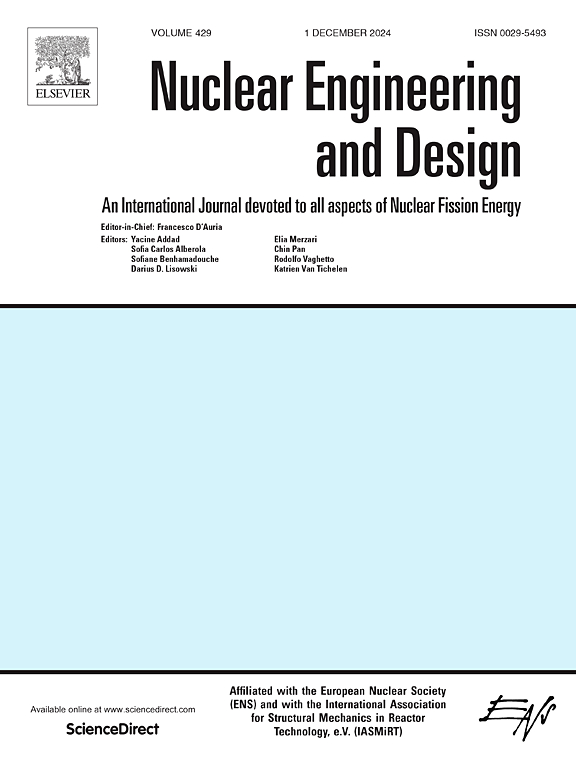Experimental investigation of thermal–hydraulic parameters on the performance of a once-through steam generator (OTSG)
IF 2.1
3区 工程技术
Q1 NUCLEAR SCIENCE & TECHNOLOGY
引用次数: 0
Abstract
The Once-Through Steam Generator (OTSG) is a critical component in multi-purpose modular small reactor power systems. In this study, a dual-loop experimental system was established to investigate the thermal–hydraulic characteristics of OTSGs, with a focus on analyzing the effects of key parameters—primary-side average temperature, load, steam pressure, and feedwater temperature—on the steady-state thermal–hydraulic behavior. Experimental results reveal that deviations in thermal parameters significantly influence the outlet steam temperature (superheat), heat transfer power, and secondary-side pressure drop. Among these parameters, the primary-side average temperature exhibits the most pronounced impact on the outlet steam temperature, followed by steam pressure, load, and feedwater temperature. Specifically, the superheat decreases as the primary-side average temperature decreases, with a more significant reduction observed near the saturation temperature. At low loads (20%–60% of full power, FP), the superheat decreases linearly with steam pressure, whereas at high loads (60%–120% FP), the rate of decrease in steam superheat intensifies with increasing steam pressure. The superheat initially increases slowly with load, reaches a maximum, and then decreases rapidly. The maximum superheat decreases with increasing steam pressure, and the load required to achieve the maximum superheat point decreases accordingly at higher pressures. Additionally, as the feedwater temperature increases, the superheat decreases, albeit at a relatively modest rate. These findings enhance the understanding of OTSG thermal–hydraulic behavior and provide valuable insights for optimizing their design and operational performance.
一次性蒸汽发生器(OTSG)热工参数对性能影响的实验研究
直通式蒸汽发生器(OTSG)是多用途模块化小型反应堆动力系统的关键部件。本研究建立了双回路实验系统,研究了水轮机热水力特性,重点分析了主侧平均温度、负荷、蒸汽压力和给水温度等关键参数对水轮机稳态热水力特性的影响。实验结果表明,热参数的偏差对出口蒸汽温度(过热度)、换热功率和二次侧压降有显著影响。其中,一次侧平均温度对出口蒸汽温度的影响最为显著,其次是蒸汽压力、负荷和给水温度。具体来说,过热度随着一次侧平均温度的降低而降低,在饱和温度附近的降低更为显著。在低负荷(满功率的20% ~ 60%,FP)下,过热度随蒸汽压力线性降低,而在高负荷(满功率的60% ~ 120%,FP)下,蒸汽过热度随蒸汽压力的增加而减小。过热度随着负荷的增加开始缓慢增加,达到最大值,然后迅速下降。最大过热度随蒸汽压力的增加而降低,在较高压力下达到最大过热度点所需的负荷也相应降低。此外,随着给水温度的升高,过热度降低,尽管速度相对缓慢。这些发现增强了对OTSG热液特性的理解,并为优化OTSG的设计和运行性能提供了有价值的见解。
本文章由计算机程序翻译,如有差异,请以英文原文为准。
求助全文
约1分钟内获得全文
求助全文
来源期刊

Nuclear Engineering and Design
工程技术-核科学技术
CiteScore
3.40
自引率
11.80%
发文量
377
审稿时长
5 months
期刊介绍:
Nuclear Engineering and Design covers the wide range of disciplines involved in the engineering, design, safety and construction of nuclear fission reactors. The Editors welcome papers both on applied and innovative aspects and developments in nuclear science and technology.
Fundamentals of Reactor Design include:
• Thermal-Hydraulics and Core Physics
• Safety Analysis, Risk Assessment (PSA)
• Structural and Mechanical Engineering
• Materials Science
• Fuel Behavior and Design
• Structural Plant Design
• Engineering of Reactor Components
• Experiments
Aspects beyond fundamentals of Reactor Design covered:
• Accident Mitigation Measures
• Reactor Control Systems
• Licensing Issues
• Safeguard Engineering
• Economy of Plants
• Reprocessing / Waste Disposal
• Applications of Nuclear Energy
• Maintenance
• Decommissioning
Papers on new reactor ideas and developments (Generation IV reactors) such as inherently safe modular HTRs, High Performance LWRs/HWRs and LMFBs/GFR will be considered; Actinide Burners, Accelerator Driven Systems, Energy Amplifiers and other special designs of power and research reactors and their applications are also encouraged.
 求助内容:
求助内容: 应助结果提醒方式:
应助结果提醒方式:


